Egypt's map has transformed over the centuries, shaped by internal developments and foreign conquests. From the unification of Upper and Lower Egypt around 3000 BCE, Egypt's strategic location between Africa and the Middle East made it a key player in regional history. It experienced the rise of empires, territorial expansions, and occupations by the Persians, Romans, Greeks, and Ottomans. After the British protectorate ended, modern borders were established. Today, Egypt is a powerful nation, blending its ancient heritage with modern political, cultural, and economic leadership.

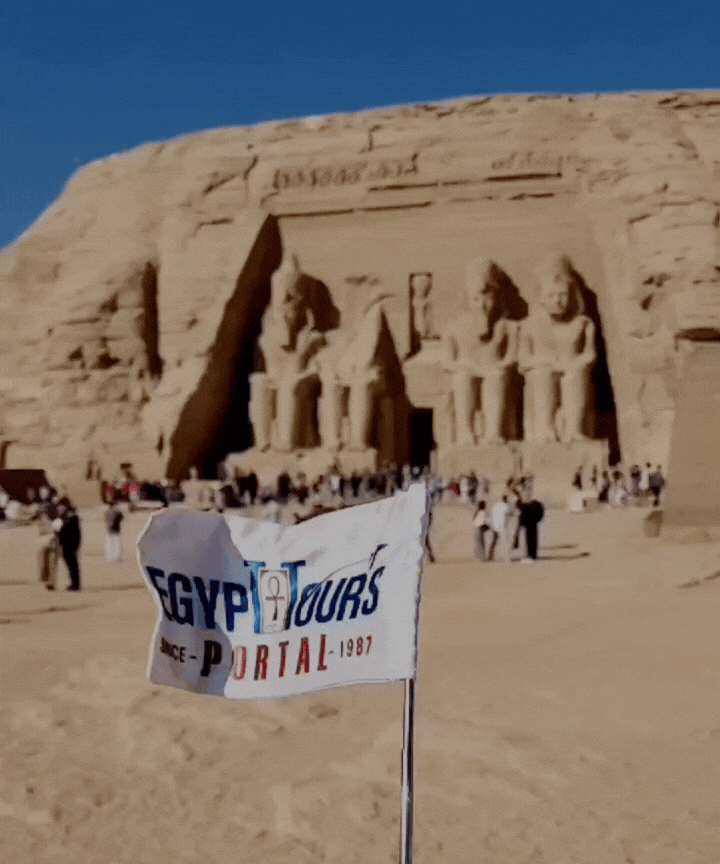
The Egypt map has transformed many times over the years as Egypt's borders have continuously shifted, reflecting the dynamic forces that have shaped its history, from internal developments to foreign conquests and alliances. This ongoing transformation was driven by both the evolution of ancient Egyptian society and the influence of external powers.
The unique geographical placement of Egypt straddling Africa and the Middle East, with access to the Mediterranean Sea and the Red Sea, played a critical role in the rise and fall of the ancient Egyptian civilization. This prime location not only fostered economic prosperity and cultural advancements but also attracted the attention of surrounding empires, each eager to control Egypt’s strategic and fertile lands.

Life in Egypt dates back over 5,000 years, but around 3500 BCE, significant changes took root along the banks of the Nile River, laying the foundation for what would become one of the world’s most remarkable civilizations.
Ancient Egyptians devised innovative ways to control the Nile’s unpredictable floods, establishing irrigation systems, dikes, and channels that would transform the region's agricultural landscape. This mastery over water management led to unprecedented prosperity and allowed for the establishment of a structured society.
A hierarchy of officials emerged, excelling in fields like administration, architecture, and mathematics, setting the groundwork for Egyptian society's remarkable achievements. By 3000 BCE, Egypt had unified under a single rule, marking the beginning of its ascent into a powerful, cohesive state.
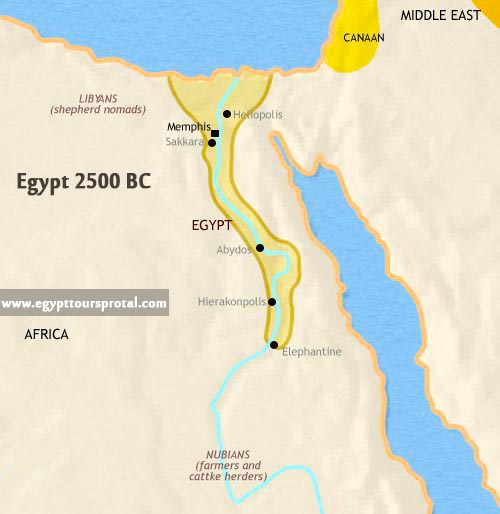
Around 2500 BCE, Egypt’s Old Kingdom took shape, centered along the Nile’s fertile valley. This era followed the unification of Upper and Lower Egypt by the legendary King Menes, who established Memphis as the new capital. The stability brought by unification spurred a population boom along the Nile, fostering the growth of influential cities such as Heliopolis and Abydos.
Memphis became an administrative and cultural hub, giving rise to architectural wonders, including the Great Pyramids, which still stand as testaments to human ingenuity. This period also set the stage for developments in religion, governance, and social organization that would define Egyptian culture for millennia.
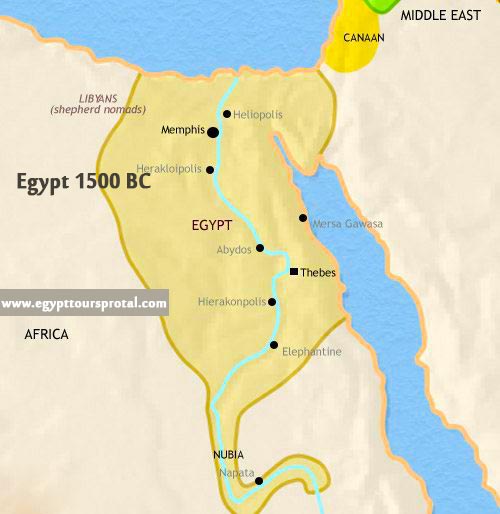
By 1500 BCE, Egypt entered the era known as the New Kingdom, a period marked by territorial expansion and grand building projects. The New Kingdom followed a time of instability during the Middle Kingdom (2050–1650 BCE), where internal divisions and administrative decline weakened Egypt. However, the New Kingdom revived Egypt’s strength, allowing it to extend its influence beyond its traditional borders, reaching into Nubia in the south and as far north as Palestine and Syria.
This expansion not only increased Egypt’s wealth but also introduced new ideas, arts, and technologies. Iconic temples in Luxor and the Valley of the Kings were constructed, becoming symbols of Egypt’s power. Legendary figures like Tutankhamun, Hatshepsut, and Ramses II solidified Egypt's prominence in the ancient world.
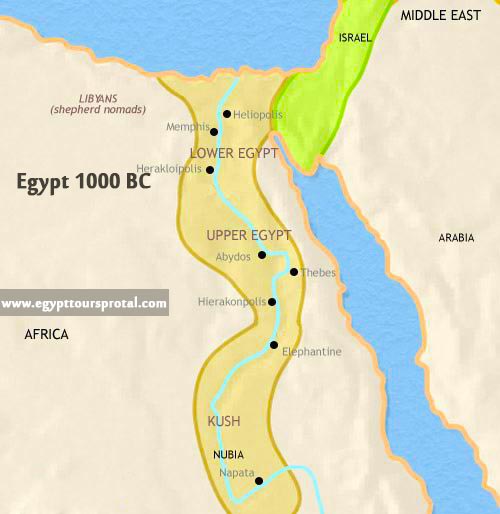

Starting around 1200 BCE, Egypt faced instability due to internal issues and external threats, eventually leading to its conquest by the Persian Empire in 525 BCE under King Cambyses II. As a Persian province, Egypt’s resources were integrated into the Persian economy through administrative reforms and new taxation systems.
Although Egyptians initially resisted, they gradually adapted to Persian influence, with Persian rulers even attempting to blend Egyptian religious customs into their own practices. Egypt remained under Persian rule for almost 200 years, preserving its ancient culture but setting the stage for future conquests.

In 332 BCE, Alexander the Great conquered Egypt, where he was welcomed as a liberator from Persian rule. He founded Alexandria, a city that soon flourished as a major hub of culture, trade, and scholarship. After Alexander’s death, his general Ptolemy took control, establishing the Ptolemaic Dynasty, which led to a fusion of Greek and Egyptian cultures.
This era, spanning nearly 300 years, saw Egypt’s economy and political influence grow under leaders like Cleopatra VII, despite facing Roman pressure. Alexandria attracted scholars and artists, leaving a lasting cultural legacy, while Egyptian traditions adapted to Greek influences.
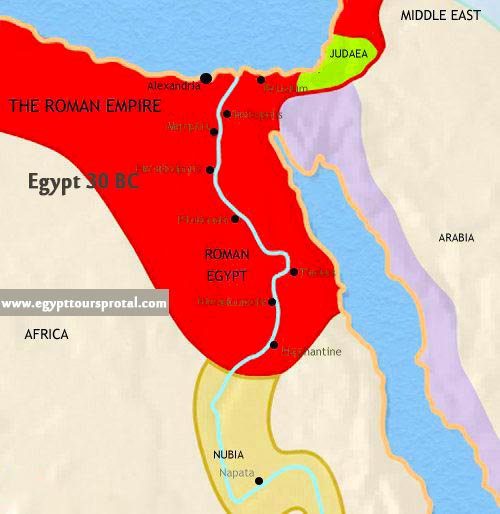
In 30 BCE, the Greek period came to an end after the suicide of the last native ruler of ancient Egypt, Queen Cleopatra, after the death of her beloved Mark Anthony. Egypt came under the control of the Roman Empire under the distant imperial capital of Rome, as a means to extract as much wealth such as grain and gold.

The fall of Queen Cleopatra VII in 30 BCE marked the end of native rule and the beginning of Roman control in Egypt. Rome valued Egypt’s rich agricultural output, turning it into a vital source of grain. Alexandria continued as a center of culture, science, and trade, blending Egyptian, Greek, and Roman traditions, which shaped Egypt’s unique architectural and artistic heritage.
Although Egypt’s autonomy was lost, its influence in art, culture, and learning persisted, making it a crucial and culturally diverse province within the Roman Empire and cementing its legacy in the Mediterranean world.
By 200 CE, Alexandria had become one of the Roman Empire’s most important cities. Egypt’s role as Rome's grain basket secured its importance, as the region supplied a substantial portion of the empire’s food. The Library of Alexandria housed vast amounts of knowledge, drawing scholars from across the Mediterranean world.
The Egyptian desert also became a repository for documents, helping preserve priceless manuscripts that would later inform modern scholars. Egypt remained a vital intellectual and economic center within the Roman world.

Around 500 CE, Egypt experienced shifts in social structure, as wealthy landowners increasingly controlled the ancient Egyptian economy. Christianity flourished, and Egypt became a spiritual center with monasticism taking root in the deserts.
Christian communities thrived, but theological differences put them at odds with the official church in Constantinople. Egypt’s Coptic Church maintained a distinct identity, contributing to the region’s unique religious landscape. This era laid the foundation for Egypt’s enduring Christian heritage, which remains a significant part of its cultural fabric today.
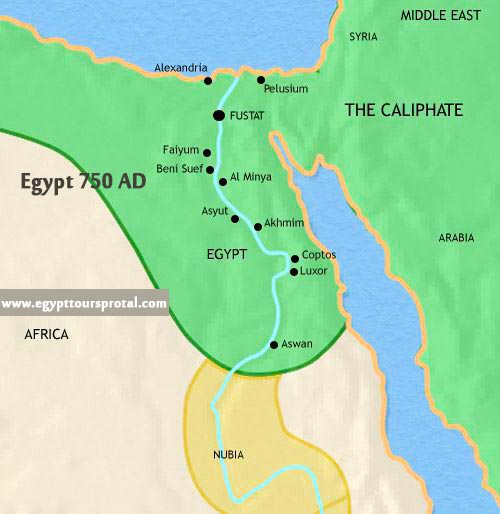
The Arab conquest in 639 CE marked a turning point, as the Muslim rulers brought new customs and language to Egypt. While initially the Arab presence was limited to the newly founded city of Fustat, the influence gradually spread, transforming Egyptian society. Arabic became the official language, and Islam gradually gained followers.
Unlike previous invasions, the Arabs were seen by many Egyptians as liberators rather than conquerors, owing to their relatively tolerant approach to religious diversity. This period reshaped Egypt’s cultural and religious landscape for centuries to come.
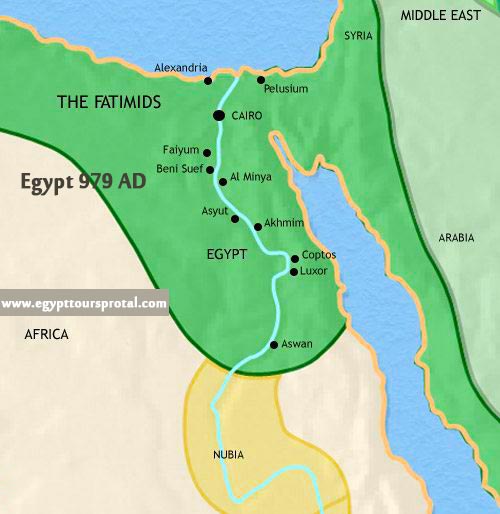
In 979 CE, the Fatimid dynasty transformed Egypt into a hub of Islamic culture, trade, and learning, establishing Cairo as the capital. They invested in infrastructure, including iconic structures like Al-Azhar Mosque, which became a renowned center for Islamic scholarship. The Fatimids also expanded agriculture, boosting Egypt’s economy.
This prosperity made Cairo a major trading and intellectual center, attracting merchants and scholars from across the Islamic world. Their contributions solidified Cairo’s identity as a lasting cultural and religious capital.

In 1170 CE, Saladin, a Kurdish general, founded the Ayyubid dynasty in Egypt, strengthening its influence by capturing Jerusalem from the Crusaders in 1187. Recognizing Cairo’s importance, Saladin fortified it with the Citadel, enhancing its defensive and political strength.
The Ayyubid dynasty grew Egypt’s political and trade connections across the Middle East, making Cairo a thriving center of Islamic learning and culture. Saladin and his successors established Egypt as a prominent power in the medieval Islamic world.
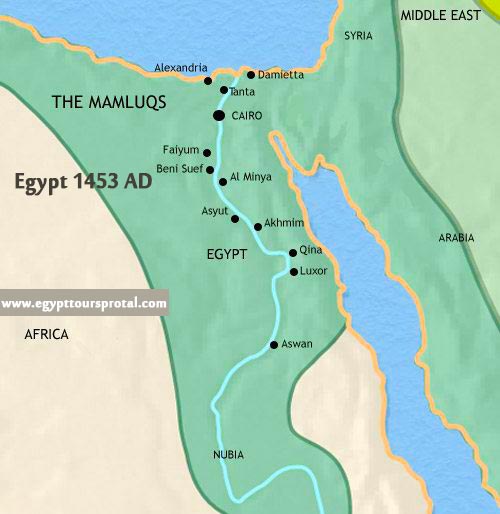
By 1453 CE, Egypt was under Mamluk rule, a class of former slave soldiers who formed a powerful military regime. They expanded Egypt’s territory and protected it from external threats, notably the Mongols in 1260 AD.
The Mamluks enriched Cairo with grand mosques and bustling markets, making it a center of Islamic art, architecture, and commerce. Egypt’s economy, culture, and influence flourished under Mamluk patronage, solidifying Cairo as a vibrant center of Arab civilization and trade.
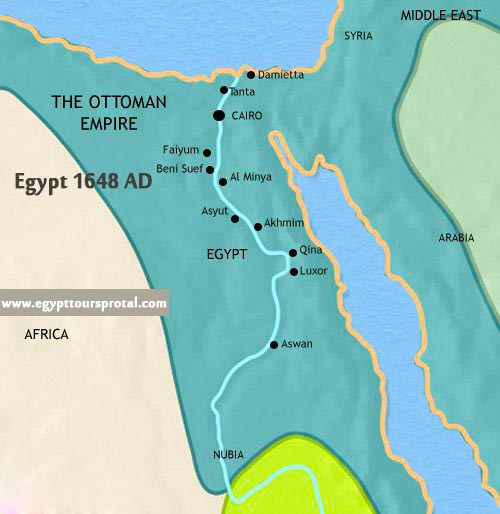
In 1517, the Ottoman Empire absorbed Egypt but allowed the Mamluk elite to retain significant local power. This arrangement gave Egypt a unique role as a key trade link in the empire, connecting Ottoman territories across the Mediterranean and North Africa.
Though nominally under Ottoman control, the Mamluks managed Egypt’s society and economy, maintaining stability and protecting its borders. Egypt’s position in the Mediterranean trade network sustained its cultural and economic relevance within the Ottoman Empire.
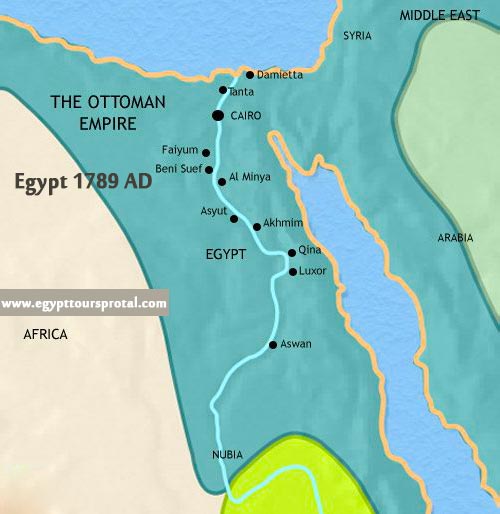
In 1789 CE, Muhammad Ali, an ambitious Ottoman governor, seized control of Egypt in 1805 and initiated widespread reforms. He modernized the military, built schools, and improved infrastructure, transforming Egypt into a quasi-independent state. His ambitious projects, including a formidable army and agricultural reforms, positioned Egypt as a regional power. Muhammad Ali’s dynasty would shape Egypt's trajectory for generations, laying the groundwork for modernization.

Mohammad Ali had plans to create his new empire outside the borders of Egypt to the point where he could replace the Ottoman regime with one of his own. He was unable to make his dream come true after he was forced to withdraw from his march on Constantinople and give up his claim to Syria in 1841, and settle for being the hereditary ruler of Egypt for himself and his successors. In 1869, the Suez Canal was opened after 10 years of construction by Egyptian labor and design by French engineers, and the control of the British government.
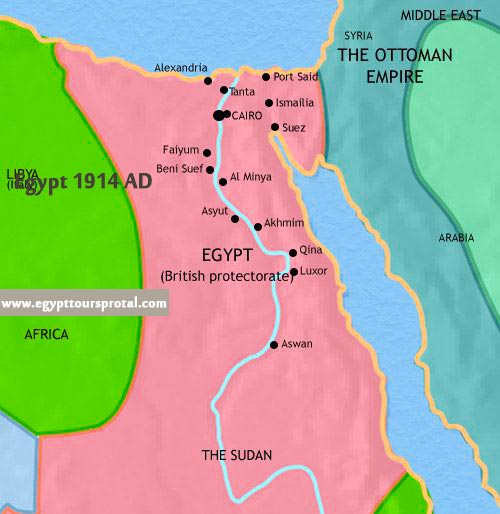
In 1914, Egypt became a British protectorate, primarily due to the strategic importance of the Suez Canal for British colonial interests. British officials took control of key areas, including finance, infrastructure, and foreign policy, implementing modernization projects that improved railways, communications, and irrigation. These changes boosted agricultural productivity, especially in cotton for British industries.
However, British dominance sparked resentment and a nationalist movement demanding independence. By the 1920s, Egypt gained limited independence as a monarchy, but British influence persisted until Egypt’s sovereignty movement intensified in the mid-20th century.
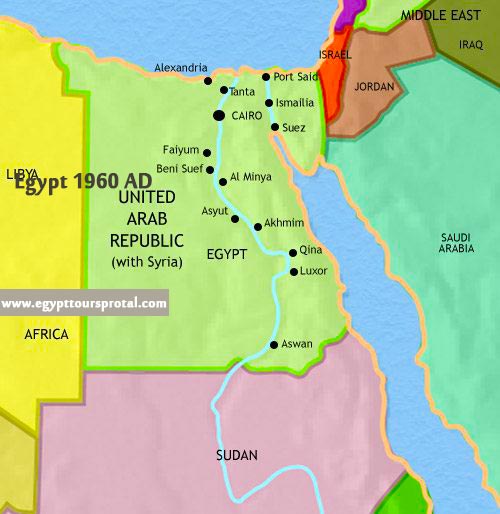
After WWII, Egypt’s push for full independence led to the 1952 revolution, which overthrew King Farouk and ended British dominance. Egypt became a republic under General Mohamed Naguib and later Gamal Abdel Nasser, who became a key figure in modern Egyptian history. Nasser’s nationalization of the Suez Canal in 1956 triggered the Suez Crisis, ending with the withdrawal of British, French, and Israeli forces, marking a victory for Egyptian sovereignty.
Nasser also pursued Pan-Arabism, briefly uniting with Syria as the United Arab Republic, and implemented land and industrial reforms. This period established Egypt’s leadership in the Arab world and laid the foundation for its modern identity.

Today, Egypt’s borders are well-defined, especially after regaining the Sinai Peninsula in 1979 through the Camp David Accords, which reinforced Egypt’s territorial integrity and role in regional stability.
Egypt has balanced its ancient heritage with modern growth, becoming a top tourism destination with sites like the Pyramids, Luxor, Sharm el-Sheik, and Hurghada. Tourism is vital to Egypt’s economy, supported by infrastructure investments. Politically, Egypt is influential in the Arab League and advocates for Middle Eastern stability, maintaining a prominent role in the region as both a cultural and economic leader.
Egypt is considered one of the top tourist countries all across the world, so if you plan a trip to Egypt, then check our Egypt tours and Nile river cruise to enjoy your dream adventure.
Private 4 Days Cairo Tour Packages for South African Travelers 4 days Cairo Egypt To...
Tour Location: Cairo – Giza...
5 Days Cairo and Alexandria Tour Package For South African Travelers 5 days Cairo an...
Tour Location: Cairo/Giza/Alexandria...
6 Days Cairo, Luxor & Aswan Tour Package For South African Travelers 6 days Cair...
Tour Location: Cairo/Giza/Aswan/Luxor...
Amazing 7 Days Cairo and Hurghada Holiday for South African Travelers 7 Days Cairo &...
Tour Location: Cairo – Giza – Hurgh...
Luxor is located in southern Egypt, on the east bank of the Nile River. It’s in Upper Egypt, approximately 650 km south of Cairo. Luxor is known for its proximity to famous ancient sites, including the Karnak Temple and the Valley of the Kings.
Alexandria is situated along the Mediterranean coast in northern Egypt. Located about 220 km northwest of Cairo, it sits on the western edge of the Nile Delta and is one of Egypt’s main ports and historical cities.
Cairo, Egypt’s capital, is positioned on the east bank of the Nile River in northern Egypt, near the head of the Nile Delta. It’s about 120 km south of the Mediterranean coast and is centrally located between Upper and Lower Egypt.
Upper Egypt extends along the Nile River from the area south of Cairo to Aswan in southern Egypt. It includes cities like Luxor, Aswan, and Qena, and is historically known as the area of the Nile Valley upriver.
Lower Egypt covers the northern Nile Delta region, including Cairo and Alexandria. It’s called "Lower" because the Nile flows from south to north, making the Delta region the lower part of the river’s course.
Giza is located on the west bank of the Nile, directly across from Cairo. It’s famous for the Giza Plateau, home to the Great Pyramids and the Sphinx. It lies about 20 km southwest of central Cairo.
Rosetta (Rashid) is located on the western edge of the Nile Delta, near where the Rosetta branch of the Nile meets the Mediterranean Sea. It is about 65 km east of Alexandria.
The Sahara Desert stretches across much of western Egypt, occupying areas west of the Nile River. It includes parts of the Western Desert, from the Mediterranean coast down to the Sudanese border.
Nubia is south of ancient Egypt, along the Nile River, extending from Aswan into present-day northern Sudan. It was historically a separate kingdom and region closely linked to Upper Egypt.
The Valley of the Kings is located on the west bank of the Nile, across from Luxor in Upper Egypt. It lies within the Theban Necropolis, near the mortuary temple of Hatshepsut.
Hurghada is located along the Red Sea coast of eastern Egypt, about 450 km southeast of Cairo. It’s a popular resort town known for beaches and marine life.
Aswan is in southern Egypt, along the Nile River, close to the border with Sudan. It’s located about 230 km south of Luxor and marks the southernmost part of Upper Egypt.
Abydos is located in Upper Egypt, west of the Nile River and about 160 km north of Luxor. It is one of Egypt’s oldest cities and an important archaeological site.
Memphis lies south of Cairo, near the town of Mit Rahina, just west of the Nile. It was the ancient capital of Egypt and is located in the Lower Egypt region, near Giza.
The Nile Valley runs from the south at Aswan through Luxor and up to Cairo in the north. It is flanked by the Eastern and Western Deserts, following the course of the Nile River through Upper and Lower Egypt.
The Sinai Peninsula is located to the east of mainland Egypt, bordered by the Mediterranean Sea to the north, the Red Sea to the south, and the Gulf of Aqaba to the east. It connects Africa with Asia.
The Sphinx is located on the Giza Plateau, just outside of Cairo, on the west bank of the Nile. It sits near the Great Pyramids of Giza.
The White Nile does not flow through Egypt; it merges with the Blue Nile in Khartoum, Sudan, forming the Nile River, which then flows northward through Egypt.
Al Minya is located in Middle Egypt, along the Nile River, about 245 km south of Cairo. It’s in a fertile region and is known for nearby archaeological sites.
The entire country of Egypt deserve to be explored with its every heavenly detail but there are places that must be seen before any other such as the breathtaking Hurghada's red sea, The wonders of Cairo the pyramids of Giza, the great sphinx, the Egyptian Museum, Khan El Khalili Bazaar, the wonders of Luxor like Valley of the Kings, Karnak & Hatshepsut temple and the wonders of Aswan such as Abu Simbel temples, Philea temple, Unfinished obelisk and The Wonders of Alexandria like Qaitbat Citadel, Pompey's Pillar and Alexandria Library. Read more about the best places to visit in Egypt.
If you want to apply for a Visa On Arrival that lasts for 30 days then you should be one of the eligible countries, have a valid passport with at least 6 months remaining and pay 25$ USD in cash, as for the E-Visa for 30 day you should have a valid passport for at least 8 months, complete the online application, pay the e-visa fee then print the e-visa to later be presented to the airport border guard. You could also be one of the lucky ones who can obtain a free visa for 90 days. Read more about Egypt travel visa.
Egypt has a variety of delicious cuisines but we recommend “Ful & Ta’meya (Fava Beans and Falafel)”, Mulukhiya, “Koshary”, a traditional Egyptian pasta dish, and Kebab & Kofta, the Egyptian traditional meat dish.
The best time to travel to Egypt is during the winter from September to April as the climate becomes a little tropical accompanied by a magical atmosphere of warm weather with a winter breeze. You will be notified in the week of your trip if the Climate is unsafe and if any changes have been made.
You should pack everything you could ever need in a small bag so you could move easily between your destinations.
We have been creating the finest vacations for more than 20 years around the most majestic destinations in Egypt. Our staff consists of the best operators, guides and drivers who dedicate all of their time & effort to make you have the perfect vacation. All of our tours are customized by Travel, Financial & Time consultants to fit your every possible need during your vacation. It doesn't go without saying that your safety and comfort are our main priority and all of our resources will be directed to provide the finest atmosphere until you return home.
You will feel safe in Egypt as the current atmosphere of the country is quite peaceful after the government took powerful measures like restructuring the entire tourist police to include all the important and tourist attractions in Egypt. Read more about is it safe to travel to Egypt.
Wear whatever feels right and comfortable. It is advised to wear something light and comfortable footwear like a closed-toe shoe to sustain the terrain of Egypt. Put on sun block during your time in Egypt in the summer to protect yourself from the sun.
The best activity is by far boarding a Nile Cruise between Luxor and Aswan or Vise Versa. Witness the beauty of Egypt from a hot balloon or a plane and try all the delicious Egyptian cuisines and drinks plus shopping in old Cairo. Explore the allure and wonders of the red sea in the magical city resorts of Egypt like Hurghada and many more by diving and snorkeling in the marine life or Hurghada. Behold the mesmerizing western desert by a safari trip under the heavenly Egyptian skies.
There are a lot of public holidays in Egypt too many to count either religious or nation, the most important festivals are the holy month of Ramadan which ends with Eid Al Fitr, Christmas and new years eve. Read more about festivals & publich holidays in Egypt.
Egypt is considered to be one of the most liberal Islamic countries but it has become a little bit conservative in the last couple of decades so it is advised to avoid showing your chest, shoulders or legs below the knees.
Arabic is the official language and Most Egyptians, who live in the cities, speak or understand English or at least some English words or phrases. Fewer Egyptians can speak French, Italian, Spanish, and German. Professional tour guides, who work in the tourism sector, are equipped to handle visitors who cannot speak Arabic and they will speak enough English and other languages to fulfill the needs of all our clients.
The fastest way is a car, of course, a taxi. If you are in Cairo ride a white taxi to move faster or you could board the fastest way of transportation in Egypt metro if the roads are in rush hour.
The temperature in Egypt ranges from 37c to 14 c. Summer in Egypt is somehow hot but sometimes it becomes cold at night and winter is cool and mild. The average of low temperatures vary from 9.5 °C in the wintertime to 23 °C in the summertime and the average high temperatures vary from 17 °C in the wintertime to 32 °C in the summertime. The temperature is moderate all along the coasts.
It is the home of everything a traveler might be looking for from amazing historical sites dating to more than 4000 years to enchanting city resorts & beaches. You will live the vacation you deserve as Egypt has everything you could possibly imagine.









